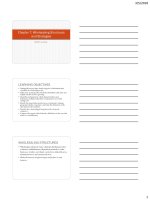Lecture Marketing channel strategy: Chapter 2 - TS. Đinh Tiến Minh
Bạn đang xem bản rút gọn của tài liệu. Xem và tải ngay bản đầy đủ của tài liệu tại đây (553.33 KB, 6 trang )
1/12/2018
Chapter 2: End-User Analysis:
Segmenting and Targeting
DINH Tien Minh
• LEARNING OBJECTIVES
– Understand the central role played by end-users and their
demands in the design of marketing channels.
– Define “service outputs” and identify and analyze them.
– Recognize how to divide a market into channel segments for the
purposes of marketing channel design or modification.
– Understand how to target channel segments to optimize sales
and profits.
– Evaluate when and whether to try to meet all expressed service
output demands in the short run in a particular market.
– Describe the relationship between service output demands and
solutions to overall channel design problems.
END-USER SEGMENTATION CRITERIA:
SERVICE OUTPUTS
• These service outputs in turn can be classified
into six general categories:
– Bulk breaking
– Spatial convenience
– Waiting or delivery time
– Product variety
– Customer service
– Information sharing
1
1/12/2018
Bulk Breaking
• Bulk breaking refers to the end-user’s ability
to buy a desired (possibly small) number of
units, even if the product or service originally’
was produced in large, batch-production lot
sizes.
• When the channel system allows end-users to
buy’ in small lots, purchases more easily
support consumption, reducing the need for
end-users to carry unnecessary inventory.
Spatial Convenience
• Spatial convenience provided by market
decentralization in wholesale and/or retail
outlets increases consumers’ satisfaction by
reducing transportation requirements and
search costs.
• Business buyers value spatial convenience too
Waiting Time
• Waiting time is the time that the end-user
must wait between ordering and receiving the
goods or postsales service.
• The longer the waiting time, the more
inconvenient it is for the end-user, who must
plan or predict consumption levels far in
advance.
2
1/12/2018
Product Variety and Assortment
• Variety describes generically different classes
of goods that constitute the product offering,
namely, the breadth of product lines.
• Assortment refers to the depth of product
brands or models offered within each generic
product category.
Customer Service
• Customer service refers to all aspects of
easing the shopping and purchase process for
end-users as they interact with commercial
suppliers (for business-to-business purchases)
or retailers (for business-to-consumer
purchases).
Information Sharing
• Information sharing refers to education
provided to end-users about product
attributes or usage capabilities, as well as preand postpurchase services.
• For some manufacturers and retailers,
information sharing has been classified as
solutions retailing.
3
1/12/2018
Price
• Price has not been listed as a service output.
• Price is what the customer pays to consume
the bundle of product + service outputs; it is
not a service that gets consumed itself.
SEGMENTING END-USERS BY SERVICE
OUTPUTS
• Different groups of end-users value service
outputs differently.
• We must consider how to group end-users
according to their service output needs, by
segmenting the market into groups of endusers who differ not in the product(s) they
want to buy, but in how they want to buy.
• There are three general steps to segmenting
end-users by service outputs.
– First, it is essential to generate a comprehensive
list of all the potential service outputs desired by
each end-user for the products being offered.
4
1/12/2018
– Second,
• The market might be divided into a priori segments (e.g.,
those often used in product or advertising decisions), then
analyzed to see whether those segments share common
purchasing preferences.
• Research might be designed and conducted to define
channel segments that best describe end-users’ service
output needs and purchasing patterns.
– Channel segmentation should be designed to produce groups of
buyers who
» (1) are maximally similar within a group
» (2) are maximally different between groups
» (3) differ on dimensions that matter for building a
distribution system.
– Third, channel manager should name each
segment to capture its identifying characteristics.
• Naming each segment facilitates internal
communication and organizational alignment, which is
helpful in executing an effective channel strategy
Service output
A
B
C
D
References and credentials
5
4
6
25
Financial Stability and longevity
4
4
5
16
Product demonstrations and trials
11
10
8
20
Proactive advice and consulting
10
9
8
10
Responsive assistance during
decision process
14
9
10
6
One-stop solution
4
1
18
3
Lowest price
32
8
8
6
Installation and training support
10
15
12
10
Responsive problem solving after
sales
8
29
10
3
Ongoing relationship with supplier
1
11
15
1
Total
100
100
100
100
% Respondents
16%
13%
61%
10%
5
1/12/2018
Segment
Name/
Descriptor
Bulk
Breaking
Spatial
Convenience
Delivery/
Waiting
Time
Assortment/
Variety
Customer
Service
Information
Sharing
1.
2.
3.
4.
INSTRUCTIONS: If quantitative market research data are available, enter numerical ratings in each cell. If not, adopt an intuitive
ranking system, noting for each segment whether demand for the given service output is HIGH, MEDIUM, or LOW.
TARGETING END-USER SEGMENTS
• Assess segment attractiveness.
• Target a subset of the segments identified.
• Customize the marketing channel system
solution used to sell to each targeted
segment.
The end!
www.dinhtienminh.net
6









